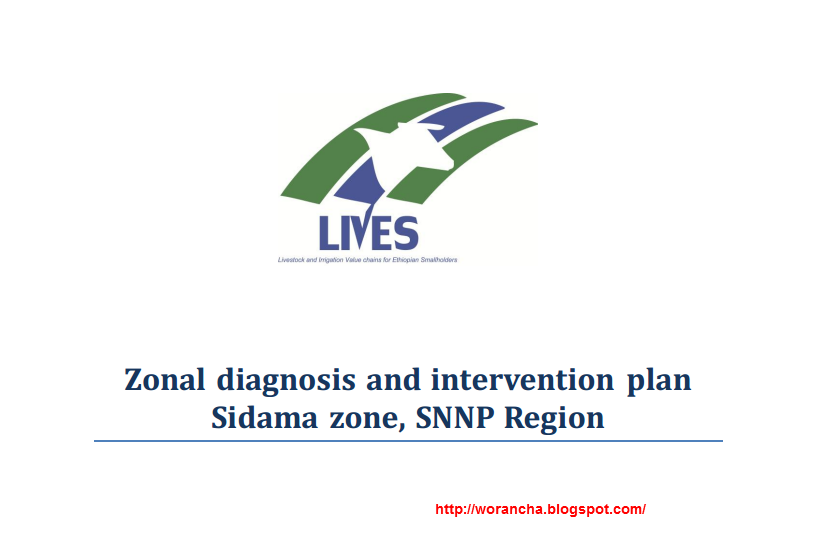Zonal diagnosis and intervention plan Sidama zone, SNNP Region
1. Introduction
The Livestock and Irrigation Value chains for Ethiopian Smallholders (LIVES) project aims at
supporting the GoE’s efforts to transform the smallholder subsistence agricultural sector to a
more market-oriented smallholder sector to contribute to the new GTP. The project will be
implemented over a 6 year period, starting April 2012 till March 2018, including a planning
phase. The project shall be implemented by the International Livestock Research Institute (ILRI)
and the International Water Management Institute (IWMI) in partnership with the Ethiopian
Institute of Agricultural Research (EIAR), the Federal Ministry of Agriculture, Regional Bureau
of Agriculture/Livestock Development Agencies and Regional Agricultural Research Institutes.
The project is funded by The Canadian International Development Agency (CIDA).
The project uses a value chain framework to develop targeted commodities. Such a framework
recognizes value chain actors who add value at different stages of the value chain and individuals
and organizations which provide inputs/ services to the value chain actors. Key value chain
actors are producers of agricultural inputs and outputs, traders and processors at village, district,
regional and national level. Important service providers include the public research and extension
sector which are involved in technology development, capacity development, knowledge
generation and dissemination. The agricultural offices are also involved in input supply and
services e.g. supply of seeds, artificial insemination, veterinary services and other agricultural
crop and livestock inputs. However, community, cooperative, farmer and private sector
involvement in producing inputs and providing services is emerging.
The project will carry out a range of activities in five focus areas: capacity development,
knowledge management, promotion, commodity value chain development and documentation.
For all activities the project will aim for a gender balanced and environmentally sustainable
development.
Project implementation will focus on clusters of Districts in 10 Zones, in which 4 priority
livestock and irrigated fruits and vegetables will be supported in the selected districts.
The Sidama Zone is one of the targeted Zones and this report documents the processes followed
to select commodities and interventions, provides diagnostic background/baseline information on
the Zone, selected Districts and selected commodity value chains. It also describes potential
interventions for capacity development, knowledge management and value chain development
complemented by a plan of action for implementation.
Read more @ http://lives-ethiopia.wikispaces.com/file/view/Sidama+zonal+report-+final.pdf
The Livestock and Irrigation Value chains for Ethiopian Smallholders (LIVES) project aims at
supporting the GoE’s efforts to transform the smallholder subsistence agricultural sector to a
more market-oriented smallholder sector to contribute to the new GTP. The project will be
implemented over a 6 year period, starting April 2012 till March 2018, including a planning
phase. The project shall be implemented by the International Livestock Research Institute (ILRI)
and the International Water Management Institute (IWMI) in partnership with the Ethiopian
Institute of Agricultural Research (EIAR), the Federal Ministry of Agriculture, Regional Bureau
of Agriculture/Livestock Development Agencies and Regional Agricultural Research Institutes.
The project is funded by The Canadian International Development Agency (CIDA).
The project uses a value chain framework to develop targeted commodities. Such a framework
recognizes value chain actors who add value at different stages of the value chain and individuals
and organizations which provide inputs/ services to the value chain actors. Key value chain
actors are producers of agricultural inputs and outputs, traders and processors at village, district,
regional and national level. Important service providers include the public research and extension
sector which are involved in technology development, capacity development, knowledge
generation and dissemination. The agricultural offices are also involved in input supply and
services e.g. supply of seeds, artificial insemination, veterinary services and other agricultural
crop and livestock inputs. However, community, cooperative, farmer and private sector
involvement in producing inputs and providing services is emerging.
The project will carry out a range of activities in five focus areas: capacity development,
knowledge management, promotion, commodity value chain development and documentation.
For all activities the project will aim for a gender balanced and environmentally sustainable
development.
Project implementation will focus on clusters of Districts in 10 Zones, in which 4 priority
livestock and irrigated fruits and vegetables will be supported in the selected districts.
The Sidama Zone is one of the targeted Zones and this report documents the processes followed
to select commodities and interventions, provides diagnostic background/baseline information on
the Zone, selected Districts and selected commodity value chains. It also describes potential
interventions for capacity development, knowledge management and value chain development
complemented by a plan of action for implementation.
Read more @ http://lives-ethiopia.wikispaces.com/file/view/Sidama+zonal+report-+final.pdf





Comments
Post a Comment